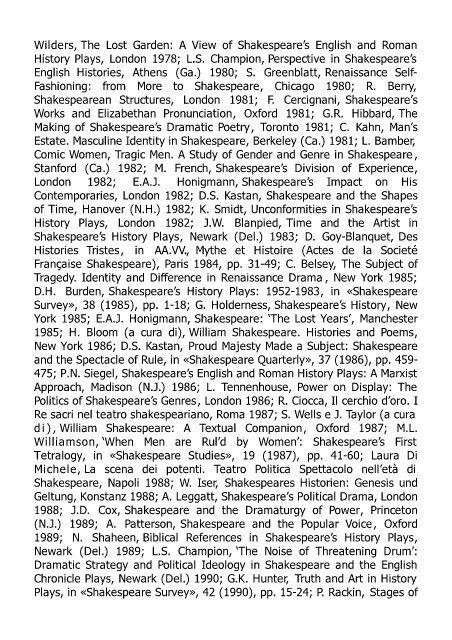Page 647 - Shakespeare - Vol. 1
P. 647
Wilders, The Lost Garden: A View of Shakespeare’s English and Roman
History Plays, London 1978; L.S. Champion, Perspective in Shakespeare’s
English Histories, Athens (Ga.) 1980; S. Greenblatt, Renaissance Self-
Fashioning: from More to Shakespeare, Chicago 1980; R. Berry,
Shakespearean Structures, London 1981; F. Cercignani, Shakespeare’s
Works and Elizabethan Pronunciation, Oxford 1981; G.R. Hibbard, The
Making of Shakespeare’s Dramatic Poetry , Toronto 1981; C. Kahn, Man’s
Estate. Masculine Identity in Shakespeare, Berkeley (Ca.) 1981; L. Bamber,
Comic Women, Tragic Men. A Study of Gender and Genre in Shakespeare ,
Stanford (Ca.) 1982; M. French, Shakespeare’s Division of Experience,
London 1982; E.A.J. Honigmann, Shakespeare’s Impact on His
Contemporaries, London 1982; D.S. Kastan, Shakespeare and the Shapes
of Time, Hanover (N.H.) 1982; K. Smidt, Unconformities in Shakespeare’s
History Plays, London 1982; J.W. Blanpied, Time and the Artist in
Shakespeare’s History Plays, Newark (Del.) 1983; D. Goy-Blanquet, Des
Histories Tristes , in AA.VV., Mythe et Histoire (Actes de la Societé
Française Shakespeare), Paris 1984, pp. 31-49; C. Belsey, The Subject of
Tragedy. Identity and Difference in Renaissance Drama , New York 1985;
D.H. Burden, Shakespeare’s History Plays: 1952-1983, in «Shakespeare
Survey», 38 (1985), pp. 1-18; G. Holderness, Shakespeare’s History, New
York 1985; E.A.J. Honigmann, Shakespeare: ‘The Lost Years’, Manchester
1985; H. Bloom (a cura di), William Shakespeare. Histories and Poems,
New York 1986; D.S. Kastan, Proud Majesty Made a Subject: Shakespeare
and the Spectacle of Rule, in «Shakespeare Quarterly», 37 (1986), pp. 459-
475; P.N. Siegel, Shakespeare’s English and Roman History Plays: A Marxist
Approach, Madison (N.J.) 1986; L. Tennenhouse, Power on Display: The
Politics of Shakespeare’s Genres , London 1986; R. Ciocca, Il cerchio d’oro. I
Re sacri nel teatro shakespeariano, Roma 1987; S. Wells e J. Taylor (a cura
d i ) , William Shakespeare: A Textual Companion, Oxford 1987; M.L.
Williamson, ‘When Men are Rul’d by Women’: Shakespeare’s First
Tetralogy, in «Shakespeare Studies», 19 (1987), pp. 41-60; Laura Di
Michele, La scena dei potenti. Teatro Politica Spettacolo nell’età di
Shakespeare, Napoli 1988; W. Iser, Shakespeares Historien: Genesis und
Geltung, Konstanz 1988; A. Leggatt, Shakespeare’s Political Drama, London
1988; J.D. Cox, Shakespeare and the Dramaturgy of Power, Princeton
(N.J.) 1989; A. Patterson, Shakespeare and the Popular Voice , Oxford
1989; N. Shaheen, Biblical References in Shakespeare’s History Plays,
Newark (Del.) 1989; L.S. Champion, ‘The Noise of Threatening Drum’:
Dramatic Strategy and Political Ideology in Shakespeare and the English
Chronicle Plays, Newark (Del.) 1990; G.K. Hunter, Truth and Art in History
Plays, in «Shakespeare Survey», 42 (1990), pp. 15-24; P. Rackin, Stages of

